Emergence of Nano-Dentistry as a Reality of Contemporary Dentistry
Abstract
:1. Introduction
- (1)
- therapeutic approaches based on the use of nanotechnology;
- (2)
- diagnostic nanomedical procedures;
- (3)
- the use of nanomaterials in the technology of manufacturing various medical devices.
2. Materials and Methods
- (1)
- The search was carried out in the Scopus database using the keywords “nanoparticles” and “dentistry”. In total, 222 records were found.
- (2)
- Five co-authors analyzed 222 records for compliance with the inclusion and exclusion criteria. In total, 147 records were deleted, i.e., 75 records remained.
- (3)
- In the reference lists of these 75 articles, we found 12 books and sections of books by highly rated publishers (Wiley, Elsevier, and Springer or affiliated with them).
- (4)
- To the 75 records from Scopus, we added 12 books and chapters of books. That is the total of 87 records. All selected records were distributed among all authors for reading of the full text articles and preparation of the manuscript. The procedure is shown in Figure 2 in the PRISMA flowchart.
3. Results
4. Discussion
4.1. Conservative Nano-Dentistry
4.1.1. Dentin/Tooth Hypersensitivity
4.1.2. Tooth Restoration Procedures with Nanomaterials
Nanocomposites
- high strength, which allows them to be used for restoration and filling procedures on anterior and posterior teeth;
- aesthetics, in particular the ability to manipulate the color shade of restorations in a wide range of values, as well as obtaining a stable shine;
- minimal polymerization shrinkage that would help avoid marginal leakage problems as it is the main reason for secondary caries progression.
Adhesives
Glass Ionomer Cement
4.1.3. Nanotechnology in Endodontic Sealers
4.1.4. Nanotechnology in Periodontology
4.2. Nanotechnology in the Surgical Field
4.2.1. Nanoanesthesia
4.2.2. Nanotechnology in Dental Implants
4.2.3. Nanotechnologies in the Correction of Deformations and Defects of Bones
4.3. Prosthetic Dentistry
4.4. Preventive Nano-Dentistry
4.5. Nanotechnologies in Diagnosis
Molecular Imaging
5. Limitations
6. Conclusions
Author Contributions
Funding
Data Availability Statement
Acknowledgments
Conflicts of Interest
References
- Seth, N.; Khan, K. Dentistry at the nano level: The advent of nanodentistry. Int. J. Health Res. 2017, 1, 3–9. [Google Scholar] [CrossRef]
- Calisir, M. Nanotechnology in Dentistry: Past, Present, and Future. In Nanomaterials for Regenerative Medicine; Humana: Cham, Switzerland, 2019; pp. 197–216. [Google Scholar]
- De Stefani, A.; Bruno, G.; Preo, G.; Gracco, A. Application of Nanotechnology in Orthodontic Materials: A State-of-the-Art Review. J. Dent. 2020, 8, 126. [Google Scholar] [CrossRef] [PubMed]
- Bhardwaj, A.; Bhardwaj, A.; Misuriya, A.; Maroli, S.; Manjula, S.; Singh, A.K. Nanotechnology in dentistry: Present and future. J. Int. Oral Health 2014, 6, 121–126. [Google Scholar] [PubMed]
- Dogra, S.; Gupta, A.; Goyal, V.; Chib, A.S.; Kataria, V. Recent trends, therapeutic applications, and future trends of nanomaterials in dentistry. In Nanomaterials in Diagnostic Tools and Devices; Elsevier: Amsterdam, The Netherlands, 2020; pp. 257–292. [Google Scholar]
- Jafari, S.M.; McClements, D.J. Nanotechnology approaches for increasing nutrient bioavailability. Adv. Food Nutr. Res. 2017, 81, 1–30. [Google Scholar] [CrossRef]
- Priyadarsini, S.; Mukherjee, S.; Mishra, M. Nanoparticles used in dentistry: A review. J. Oral Biol. Craniofacial Res. 2018, 8, 58–67. [Google Scholar] [CrossRef] [PubMed] [Green Version]
- Barot, T.; Rawtani, D.; Kulkarni, P. (Eds.) Nanotechnology-based materials as emerging trends for dental applications. Rev. Adv. Mater. 2021, 60, 173–189. [Google Scholar] [CrossRef]
- Kanchi, S.; Sharma, D. (Eds.) Nanomaterials in Diagnostic Tools and Devices; Elsevier: Amsterdam, The Netherlands, 2020. [Google Scholar]
- Altintas, Z. (Ed.) Biosensors and Nanotechnology: Applications in Health Care Diagnostics; John Wiley & Sons: Hoboken, NJ, USA, 2017. [Google Scholar]
- Anatychuk, L.; Kochan, O.; Pasechnikova, N.; Naumenko, V.; Zadorozhnyi, O.; Vikhor, L.; Levkiv, M. Thermoelectric Medical Device for Measuring Heat Flux from Ocular Surface. In Proceedings of the 2021 13th International Conference on Measurement, Smolence, Slovakia, 17–19 May 2021; pp. 178–181. [Google Scholar]
- Kochan, O.; Przystupa, K.; Shulhai, A.; Pohrebennyk, V.; Su, J.; Koziel, J. Ad-hoc temperature measurements using a thermistor. In Proceedings of the 2019 12th International Conference on Measurement, Smolence, Slovakia, 27–29 May 2019; pp. 228–231. [Google Scholar]
- Gurevitch, J.; Koricheva, J.; Nakagawa, S.; Stewart, G. Meta-analysis and the science of research synthesis. Nature 2018, 555, 175–182. [Google Scholar] [CrossRef]
- Mendenhall, W.; Sincich, T.; Boudreau, N.S. A Second Course in Statistics: Regression Analysis, 7th ed.; Prentice Hall: Upper Saddle River, NJ, USA, 2012. [Google Scholar]
- DeCoursey, W. Statistics and Probability for Engineering Applications; Elsevier: Amsterdam, The Netherlands, 2003. [Google Scholar]
- Bird, J. Higher Engineering Mathematics; Routledge: London, UK, 2017; 897p. [Google Scholar]
- Yeromenko, V.; Kochan, O. The conditional least squares method for thermocouples error modeling. In Proceedings of the 2013 IEEE 7th International Conference on Intelligent Data Acquisition and Advanced Computing Systems (IDAACS), Berlin, Germany, 12–14 September 2013; Volume 1, pp. 157–162. [Google Scholar]
- Kvaterniuk, S.; Petruk, V.; Kochan, O.; Frolov, V. Multispectral Ecological Control of Parameters of Water Environments Using a Quadrocopter. In Sustainable Production: Novel Trends in Energy, Environment and Material Systems. Studies in Systems, Decision and Control; Królczyk, G., Wzorek, M., Król, A., Kochan, O., Su, J., Kacprzyk, J., Eds.; Springer: Cham, Switzerland, 2020; Volume 198, pp. 75–89. [Google Scholar] [CrossRef]
- Hill, R.C.; Griffiths, W.E.; Lim, G.C. Principles of Econometrics; John Wiley & Sons: Hoboken, NJ, USA, 2018. [Google Scholar]
- Chen, J.; Su, J.; Kochan, O.; Levkiv, M. Metrological Software Test for Simulating the Method of Determining the Thermocouple Error in Situ During Operation. Meas. Sci. Rev. 2018, 18, 52–58. [Google Scholar] [CrossRef] [Green Version]
- Krolczyk, G.; Gajek, M.; Legutko, S. Predicting the tool life in the dry machining of duplex stainless steel. Eksploatacja i Niezawodność 2013, 15, 62–65. [Google Scholar]
- Foong, L.K.; Foroughi, M.M.; Mirhosseini, A.F.; Safaei, M.; Jahani, S.; Mostafavi, M.; Khatami, M. Applications of nano-materials in diverse dentistry regimes. RSC Adv. 2020, 10, 15430–15460. [Google Scholar] [CrossRef]
- Shashirekha, G.; Jena, A.; Mohapatra, S. Nanotechnology in Dentistry: Clinical Applications, Benefits, and Hazards. Compend. Contin. Educ. Dent. 2017, 38, e1–e4. [Google Scholar] [CrossRef] [PubMed] [Green Version]
- Onwubu, S.C.; Mdluli, P.S.; Singh, S. The Effectiveness of Nanomaterials in the Management of Dentine Hypersensitivity-A review. J. Clin. Rev. Case Rep. 2018, 3, 1–5. [Google Scholar]
- Olley, R.C.; Sehmi, H. The rise of dentine hypersensitivity and tooth wear in an ageing population. Br. Dent. J. 2017, 223, 293–297. [Google Scholar] [CrossRef] [PubMed] [Green Version]
- Ogihara, T.; Tomiyama, K.; Iizuka, J.; Ishizawa, M.; Shiiya, T.; Mukai, Y. Effects of desensitizer containing fluoroaluminocalciumsilicate glass nanoparticles on remineralization of root dentin subsurface lesions in vitro. Dent. Mater. J. 2021, 40, 1027–1032. [Google Scholar] [CrossRef] [PubMed]
- Mitthra, S.; Karthick, A.; Anuradha, B.; Mensudar, R.; Sadhana, K.R.; Varshini, G.N. Nanorobots–A small wonder. Biosci. Biotechnol. Res. 2016, 13, 2131–2134. [Google Scholar] [CrossRef]
- Şuhani, M.F.; Băciuţ, G.; Băciuţ, M.; Şuhani, R.; Bran, S. Current perspectives regarding the application and incorporation of silver nanoparticles into dental biomaterials. Clujul Med. 2018, 91, 274–279. [Google Scholar] [CrossRef]
- Balhaddad, A.A.; Kansara, A.A.; Hidan, D.; Weir, M.D.; Xu, H.; Melo, M. Toward dental caries: Exploring nanoparticle-based platforms and calcium phosphate compounds for dental restorative materials. Bioact. Mater. 2018, 4, 43–55. [Google Scholar] [CrossRef]
- Al-Dulaijan, Y.A.; Cheng, L.; Weir, M.D.; Melo, M.A.S.; Liu, H.; Oates, T.W.; Xu, H.H. Novel rechargeable calcium phosphate nanocomposite with antibacterial activity to suppress biofilm acids and dental caries. J. Dent. 2018, 72, 44–52. [Google Scholar] [CrossRef] [PubMed]
- Iftikhar, S.; Jahanzeb, N.; Saleem, M.; Rehman, S.; Matinlinna, J.P.; Khan, A.S. The trends of dental biomaterials research and future directions: A mapping review. Saudi Dent. J. 2021, 33, 229. [Google Scholar] [CrossRef]
- Alsuraifi, A. Metallic Nanoparticles in Dental Biomaterials: A review. AAJMS [Formerly IJMS] 2020, 3, 27–37. [Google Scholar]
- Nirubama, K.; Rajeshkumar, S. Enhanced antibacterial activity of silver nanoparticles synthesised using symplocos racemosa. Int. J. Pharm. 2020, 11, 4120–4125. [Google Scholar] [CrossRef]
- Almatroudi, A. Silver nanoparticles: Synthesis, characterisation and biomedical applications. Open Life Sci. 2020, 15, 819–839. [Google Scholar] [CrossRef] [PubMed]
- Raorane, D.; Pednekar, S.; Dashaputra, R. Dental Applications of Nanotechnology; Chaughule, R.S., Ed.; Springer: Berlin/Heidelberg, Germany, 2018. [Google Scholar]
- Beyth, N.; Yudovin-Farber, I.; Basu, A.; Weiss, E.I.; Domb, A.J. Antimicrobial nanoparticles in restorative composites. In Emerging Nanotechnologies in Dentistry; William Andrew Publishing: Norwich, UK, 2018; pp. 41–58. [Google Scholar]
- Song, W.; Ge, S. Application of antimicrobial nanoparticles in dentistry. Molecules 2019, 24, 1033. [Google Scholar] [CrossRef] [PubMed] [Green Version]
- Noori, A.J.; Kareem, F.A. The effect of magnesium oxide nanoparticles on the antibacterial and antibiofilm properties of glass-ionomer cement. Heliyon 2019, 5, e02568. [Google Scholar] [CrossRef] [Green Version]
- Santoso, J.; Purbiati, M. Antibacterial activity of silver nanoparticles on fixed retainer adhesive toward treponema denticola. Int. J. Appl. Pharm. 2019, 11, 198–200. [Google Scholar] [CrossRef]
- Prabha, R.D.; Kandasamy, R.; Sivaraman, U.S.; Nandkumar, M.A.; Nair, P.D. Antibacterial nanosilver coated orthodontic bands with potential implications in dentistry. Indian J. Med. Res. 2016, 144, 580. [Google Scholar]
- Freitas, F.; Pinheiro de Melo, T.; Delgado, A.H.; Monteiro, P.; Rua, J.; Proença, L.; Mendes, J.J. Varying the Polishing Protocol Influences the Color Stability and Surface Roughness of Bulk-Fill Resin-Based Composites. J. Funct. Biomater. 2021, 12, 1. [Google Scholar] [CrossRef]
- Lee, J.H.; Seo, S.J.; Kim, H.W. Bioactive glass-based nanocomposites for personalized dental tissue regeneration. Dent. Mater. J. 2016, 35, 710–720. [Google Scholar] [CrossRef] [Green Version]
- Lopes, I.A.D.; Monteiro, P.J.V.C.; Mendes, J.J.B.; Gonçalves, J.M.R.; Caldeira, F.J.F. The effect of different finishing and polishing techniques on surface roughness and gloss of two nanocomposites. Saudi Dent. J. 2018, 30, 197–207. [Google Scholar] [CrossRef]
- Mitra, S.B. Nanoparticles for Dental Materials: Synthesis, Analysis, and Applications. In Emerging Nanotechnologies in Dentistry; William Andrew Publishing: Norwich, UK, 2018; pp. 17–39. [Google Scholar]
- Pieniak, D.; Walczak, A.; Walczak, M.; Przystupa, K.; Niewczas, A.M. Hardness and wear resistance of dental biomedical nanomaterials in a humid environment with non-stationary temperatures. Materials 2020, 13, 1255. [Google Scholar] [CrossRef] [Green Version]
- Panchbhai, A. Nanocomposites: Past, Present, and Future of Dentistry. In Applications of Nanocomposite Materials in Dentistry; Woodhead Publishing: Cambridge, UK, 2019; pp. 181–190. [Google Scholar]
- Subramani, K.; Ahmed, W. (Eds.) Emerging Nanotechnologies in Dentistry; William Andrew: Norwich, NY, USA, 2017. [Google Scholar]
- Nassif, M.; El Askary, F. Nanotechnology and Nanoparticles in Contemporary Dental Adhesives. In Nanobiomaterials in Clinical Dentistry; Elsevier: Amsterdam, The Netherlands, 2019; pp. 163–198. [Google Scholar]
- Carvalho, E.V.; De Paula, D.M.; Neto, D.A.; Costa, L.S.; Dias, D.F.; Feitosa, V.P.; Fechine, P.B.A. Radiopacity and mechanical properties of dental adhesives with strontium hydroxyapatite nanofillers. J. Mech. Behav. Biomed. 2020, 101, 103447. [Google Scholar] [CrossRef] [PubMed]
- Althomali, Y.M.; Ebrahim, M.I. Microshear bond strength of Nano-Bond adhesive containing nanosized aluminum trioxide particles. J. Orthod. Sci. 2017, 6, 71–75. [Google Scholar] [CrossRef] [PubMed]
- 3M ESPE. Available online: https://multimedia.3m.com/mws/media/546458O/3m-espe-adhesive-technology-review.pdf (accessed on 22 October 2021).
- Sajjad, A.; Bakar, W.Z.W.; Mohamad, D.; Kannand, T.P. Characterization and efficacy of fluoride elusion of a novel glass ionomer nano zirconia silica hydroxyapatite hybrid material. Fluoride 2019, 52, 507–516. [Google Scholar]
- Mirsasaani, S.S.; Hemati, M.; Dehkord, E.S.; Yazdi, G.T.; Poshtiri, D.A. Nanotechnology and nanobiomaterials in dentistry. In Nanobiomaterials in Clinical Dentistry; Elsevier: Amsterdam, The Netherlands, 2019; pp. 19–37. [Google Scholar]
- Hannig, M.; Hannig, C. Nanobiomaterials in preventive dentistry. In Nanobiomaterials in Clinical Dentistry; Elsevier: Amsterdam, The Netherlands, 2019; pp. 201–223. [Google Scholar]
- Vasiliu, S.; Racovita, S.; Gugoasa, I.A.; Lungan, M.A.; Popa, M.; Desbrieres, J. The Benefits of Smart Nanoparticles in Dental Applications. Int. J. Mol. Sci. 2021, 22, 2585. [Google Scholar] [CrossRef] [PubMed]
- Najeeb, S.; Khurshid, Z.; Zafar, M.S.; Khan, A.S.; Zohaib, S.; Martí, J.M.N.; Rehman, I.U. Modifications in glass ionomer cements: Nano-sized fillers and bioactive nanoceramics. Int. J. Mol. Sci. 2016, 17, 1134. [Google Scholar] [CrossRef] [PubMed] [Green Version]
- AlOtaibi, G. Recent advancements in glass ionomer materials with introduction of nanotechnology: A review. Int J Oral Dent Health. 2019, 7, 21. [Google Scholar] [CrossRef]
- Loyola-Rodríguez, J.P.; Torres-Méndez, F.; Espinosa-Cristobal, L.F.; García-Cortes, J.O.; Loyola-Leyva, A.; González, F.J.; Contreras-Palma, G. Antimicrobial activity of endodontic sealers and medications containing chitosan and silver nanoparticles against Enterococcus faecalis. J. Appl. Biomater. Funct. Mater. 2019, 17, 2280800019851771. [Google Scholar] [CrossRef] [Green Version]
- Ioannidis, K.; Niazi, S.; Mylonas, P.; Mannocci, F.; Deb, S. The synthesis of nano silver-graphene oxide system and its efficacy against endodontic biofilms using a novel tooth model. Dent. Mater. 2019, 35, 1614–1629. [Google Scholar] [CrossRef]
- Leng, D.; Li, Y.; Zhu, J.; Liang, R.; Zhang, C.; Zhou, Y.; Li, J. The Antibiofilm activity and mechanism of nanosilver-and nanozinc-incorporated mesoporous calcium-silicate nanoparticles. Int. J. Nanomed. 2020, 15, 3921. [Google Scholar] [CrossRef]
- Gonzalez-Luna, I.P.; Martínez-Castañón, G.A.; Zavala-Alonso, N.V.; Patiño-Marin, N.; Niño-Martínez, N.; Morán-Martínez, J.; Ramírez-González, J.H. Bactericide effect of silver nanoparticles as a final irrigation agent in endodontics on Enterococcus faecalis: An ex vivo study. J. Nanomater. 2016, 2016, 7597295. [Google Scholar] [CrossRef] [Green Version]
- Santos, J.M.; Coelho, C.M.; Sequeira, D.B.; Marques, J.A.; Pereira, J.F.; Sousa, V.; Palma, P.J.; Santos, A.C. Subcutaneous implantation assessment of new calcium-silicate based sealer for warm obturation. Biomedicines 2021, 9, 24. [Google Scholar] [CrossRef] [PubMed]
- Gandolfi, M.G.; Siboni, F.; Prati, C. Properties of a novel polysiloxane-guttapercha calcium silicate-bioglass-containing root canal sealer. Dent. Mater. 2016, 32, 113–126. [Google Scholar] [CrossRef] [PubMed]
- Dastorani, M.; Malekpour, B.; AminSobhani, M.; Alemrajabi, M.; Mahdian, A.; Malekpour, B. Comparison of bacterial microleakage of three bioactive endodontic sealers in simulated underwater diving and aviation conditions. BMC Oral Health 2021, 21, 345. [Google Scholar] [CrossRef]
- Yin, I.X.; Zhang, J.; Zhao, I.S.; Mei, M.L.; Li, Q.; Chu, C.H. The Antibacterial Mechanism of Silver Nanoparticles and Its Application in Dentistry. Int. J. Nanomed. 2020, 15, 2555–2562. [Google Scholar] [CrossRef] [Green Version]
- Raura, N.; Garg, A.; Arora, A.; Roma, M. Nanoparticle technology and its implications in endodontics: A review. Biomater. Res. 2020, 24, 21. [Google Scholar] [CrossRef] [PubMed]
- Wong, J.; Zou, T.; Lee, A.; Zhang, C. The Potential Translational Applications of Nanoparticles in Endodontics. Int. J. Nanomed. 2021, 16, 2087–2106. [Google Scholar] [CrossRef] [PubMed]
- Zakrzewski, W.; Dobrzyński, M.; Zawadzka-Knefel, A.; Lubojański, A.; Dobrzyński, W.; Janecki, M.; Kurek, K.; Szymonowicz, M.; Wiglusz, R.J.; Rybak, Z. Nanomaterials application in endodontics. Materials 2021, 14, 5296. [Google Scholar] [CrossRef]
- Verma, S.; Chandra, A.; Jena, A.; Sharan, J. Nanotechnology in Endodontics: A Hope or Hype. Trends Biomater. Artif. Organs 2021, 35, 190–202. [Google Scholar]
- Vishwanath, V.; Rao, H.M. Gutta-percha in endodontics-A comprehensive review of material science. J. Conserv. Dent. 2019, 22, 216–222. [Google Scholar] [CrossRef]
- Tan, O.L.; Safii, S.H.; Razali, M. Commercial local pharmacotherapeutics and adjunctive agents for nonsurgical treatment of periodontitis: A contemporary review of clinical efficacies and challenges. Antibiotics 2020, 9, 11. [Google Scholar] [CrossRef] [Green Version]
- Jandt, K.D.; Watts, D.C. Nanotechnology in dentistry: Present and future perspectives on dental nanomaterials. Dent Mater. 2020, 36, 1365–1378. [Google Scholar] [CrossRef]
- Liang, J.; Peng, X.; Zhou, X.; Zou, J.; Cheng, L. Emerging applications of drug delivery systems in oral infectious diseases prevention and treatment. Molecules 2020, 25, 516. [Google Scholar] [CrossRef] [Green Version]
- Patel, S.K.; Greene, A.C.; Desai, S.M.; Rothstein, S.; Basha, I.T.; MacPherson, J.S.; Rohan, L.C. Biorelevant and screening dissolution methods for minocycline hydrochloride microspheres intended for periodontal administration. Int. J. Pharm. 2021, 596, 120261. [Google Scholar] [CrossRef]
- Kishen, A. Nanotechnology in Endodontics; Springer International: Cham, Switzerland, 2016. [Google Scholar]
- Mok, Z.H.; Proctor, G.; Thanou, M. Emerging nanomaterials for dental treatments. Emerg. Top. Life Sci. 2020, 4, 613–625. [Google Scholar] [CrossRef]
- Carter, S.D.; Costa, P.F.; Vaquette, C.; Ivanovski, S.; Hutmacher, D.W.; Malda, J. Additive Biomanufacturing: An Advanced Approach for Periodontal Tissue Regeneration. Ann. Biomed. Eng. 2017, 45, 12–22. [Google Scholar] [CrossRef] [Green Version]
- Bordoloi, P.; Shahira, S.; Ramesh, A.; Thomas, B. Nanorobotic wonders: A revolutionary era in periodontics. Indian J. Multidiscip. Dent. 2018, 8, 101. [Google Scholar] [CrossRef]
- Mazumder, S.; Biswas, G.R.; Majee, S.B. Applications of Nanorobots in Medical Techniques. Int. J. Pharm. Sci. Res. 2020, 11, 3138–3147. [Google Scholar] [CrossRef]
- Subramani, K.; Mathew, R.T.; Pachauri, P. Titanium surface modification techniques for dental implants—from microscale to nanoscale. In Emerging Nanotechnologies in Dentistry, 2nd ed.; William Andrew Publishing: Norwich, UK, 2018; pp. 99–124. [Google Scholar] [CrossRef]
- Jadhav, K.; Rajeshwari, H.R.; Deshpande, S.; Jagwani, S.; Dhamecha, D.; Jalalpure, S.; Baheti, D. Phytosynthesis of gold nanoparticles: Characterization, biocompatibility, and evaluation of its osteoinductive potential for application in implant dentistry. Mater. Sci. Eng. C 2018, 93, 664–670. [Google Scholar] [CrossRef]
- Chouirfa, H.; Bouloussa, H.; Migonney, V.; Falentin-Daudré, C. Review of titanium surface modification techniques and coatings for antibacterial applications. Acta Biomater. 2019, 83, 37–54. [Google Scholar] [CrossRef]
- Subramani, K.; Lavenus, S.; Rozé, J.; Louarn, G.; Layrolle, P. Impact of nanotechnology on dental implants. In Emerging Nanotechnologies in Dentistry; Springer: Berlin/Heidelberg, Germany, 2018; pp. 83–97. [Google Scholar] [CrossRef]
- Rasouli, R.; Barhoum, A.; Uludag, H. A review of nanostructured surfaces and materials for dental implants: Surface coating, patterning and functionalization for improved performance. Biomater. Sci. 2018, 6, 1312–1338. [Google Scholar] [CrossRef]
- Comune, M.; Rai, A.; Palma, P.; TondaTuro, C.; Ferreira, L. Antimicrobial and pro-angiogenic properties of soluble and nanoparticle-immobilized LL37 peptides. Biomater. Sci. 2021, 9, 8153–8159. [Google Scholar] [CrossRef]
- Nandagopal, N.; Usha, M.; Sreejith, S.; Rajan, S. A clinical review of nanotechnology in maxillofacial practice. J. Oral Res. Rev. 2021, 13, 149–160. [Google Scholar] [CrossRef]
- Makvandi, P.; Josic, U.; Delfi, M.; Pinelli, F.; Jahed, V.; Kaya, E.; Ashrafizadeh, M.; Zarepour, A.; Rossi, F.; Zarrabi, A.; et al. Drug Delivery (Nano) Platforms for Oral and Dental Applications: Tissue Regeneration, Infection Control, and Cancer Management. Adv. Sci. 2021, 8, 2004014. [Google Scholar] [CrossRef]
- Azari, A.; Nikzad, S.; Yazdani, A.; Atri, F.; Anvari-Yazdi, A.F. Deposition of crystalline hydroxyapatite nano-particle on zirconia ceramic: A potential solution for the poor bonding characteristic of zirconia ceramics to resin cement. J. Mater. Sci. Mate.r Med. 2017, 28, 111. [Google Scholar] [CrossRef]
- Uskoković, V.; Abuna, G.; Ferreira, P.; Wu, V.M.; Gower, L.; Pires-de-Souza, F.C.P.; Geraldeli, S. Synthesis and characterization of nanoparticulate niobium-and zinc-doped bioglass-ceramic/chitosan hybrids for dental applications. J. Sol-Gel Sci. Technol. 2021, 97, 245–258. [Google Scholar] [CrossRef]
- Abd Alwahab, S.; Moosa, J.M.; Muafaq, S. Studying the Influence of Nano ZnO and Nano ZrO2 Additives on Properties of PMMA Denture Base. Indian J. Public Health Res. Dev. 2020, 11, 2047–2051. [Google Scholar] [CrossRef]
- Domagała, I.; Przystupa, K.; Firlej, M.; Pieniak, D.; Gil, L.; Borucka, A.; Levkiv, M. Analysis of the Statistical Comparability of the Hardness and Wear of Polymeric Materials for Orthodontic Applications. Materials 2021, 14, 2925. [Google Scholar] [CrossRef]
- Wang, R.; Kayacan, R.; Küçükeşmen, C. Nanotubes/polymethyl methacrylate composite resins as denture base materials. In Carbon Nanomaterials for Biomedical Applications; Springer: Cham, Switzerland, 2016; pp. 227–240. [Google Scholar]
- Zakrzewski, W.; Dobrzynski, M.; Dobrzynski, W.; Zawadzka-Knefel, A.; Janecki, M.; Kurek, K.; Lubojanski, A.; Szymonowicz, M.; Rybak, Z.; Wiglusz, R.J. Nanomaterials Application in Orthodontics. Nanomaterials 2021, 11, 337. [Google Scholar] [CrossRef]
- Zhou, L.; Wong, H.M.; Li, Q.L. Anti-Biofouling Coatings on the Tooth Surface and Hydroxyapatite. Int. J. Nanomed. 2020, 15, 8963. [Google Scholar] [CrossRef]
- Raval, C.; Vyas, K.; Gandhi, U.; Patel, B.; Patel, P. Nanotechnology in dentistry: A review. J. Adv. Med. Dent. Sci. Res. 2016, 4, 51–53. [Google Scholar]
- AlKahtani, R.N. The implications and applications of nanotechnology in dentistry: A review. Saudi Dent. J. 2018, 30, 107–116. [Google Scholar] [CrossRef]
- Fernandez, C.C.; Sokolonski, A.R.; Fonseca, M.S.; Stanisic, D.; Araújo, D.B.; Azevedo, V.; Tasic, L. Applications of Silver Nanoparticles in Dentistry: Advances and Technological Innovation. Int. J. Mol. Sci. 2021, 22, 2485. [Google Scholar] [CrossRef]
- Al-Ajely, M.S.; Ziadan, K.M.; Al-Bader, R.M. Preparation and characterization of calcium fluoride nano particles for dental applications. Int. J. Res. Granthaalayah 2018, 6, 338–346. [Google Scholar] [CrossRef]
- Emerenciano, N.G.; Delbem, A.C.B.; Pessan, J.P.; Nunes, G.P.; Neto, F.N.S.; de Camargo, E.R.; Danelon, M. In situ effect of fluoride toothpaste supplemented with nano-sized sodium trimetaphosphate on enamel demineralization prevention and biofilm composition. Arch. Oral Biol. 2018, 96, 223–229. [Google Scholar] [CrossRef]
- Ebadifar, A.; Nomani, M.; Fatemi, S.A. Effect of nano-hydroxyapatite toothpaste on microhardness of artificial carious lesions created on extracted teeth. J. Dent. Res. Den.t Clin. Dent. Prospect. 2017, 11, 14–17. [Google Scholar] [CrossRef] [Green Version]
- Ahmed, F.; Prashanth, S.T.; Sindhu, K.; Nayak, A.; Chaturvedi, S. Antimicrobial efficacy of nanosilver and chitosan against Streptococcus mutans, as an ingredient of toothpaste formulation: An in vitro study. J. Indian Soc. Pedod. Prev. Dent. 2019, 37, 46–54. [Google Scholar] [CrossRef]
- Jones, N.A.; Chang, S.Y.; Troske, W.J.; Clarkson, B.H.; Lahann, J. Carious Lesions: Nanoparticle-Based Targeting and Detection of Microcavities. Adv. Healthc. Mater. 2017, 6, 1600883. [Google Scholar] [CrossRef]
- Schneider, H.; Park, K.J.; Häfer, M.; Rüger, C.; Schmalz, G.; Krause, F.; Haak, R. Dental applications of optical coherence tomography (OCT) in cariology. Appl. Sci. 2017, 7, 472. [Google Scholar] [CrossRef] [Green Version]
- Lin, B.; Wu, J.; Wang, Y.; Sun, S.; Yuan, Y.; Tao, X.; Lv, R. Peptide functionalized upconversion/NIR II luminescent nanoparticles for targeted imaging and therapy of oral squamous cell carcinoma. Biomater. Sci. 2021, 9, 1000–1007. [Google Scholar] [CrossRef]
- Shanavas, A.; Sasidharan, S.; Bahadur, D.; Srivastava, R. Magnetic core-shell hybrid nanoparticles for receptor targeted anti-cancer therapy and magnetic resonance imaging. J. Colloid Interface Sci. 2017, 486, 112–120. [Google Scholar] [CrossRef]
- van Manen, L.; Dijkstra, J.; Boccara, C.; Benoit, E.; Vahrmeijer, A.L.; Gora, M.J.; Mieog, J.S.D. The clinical usefulness of optical coherence tomography during cancer interventions. J. Cancer Res. Clin. Oncol. 2018, 144, 1967–1990. [Google Scholar] [CrossRef] [PubMed] [Green Version]
- Jiang, Y.; Pu, K. Advanced photoacoustic imaging applications of near-infrared absorbing organic nanoparticles. Small 2017, 13, 1700710. [Google Scholar] [CrossRef]
- Chen, X.J.; Zhang, X.Q.; Liu, Q.; Zhang, J.; Zhou, G. Nanotechnology: A promising method for oral cancer detection and diagnosis. J. Nanobiotechnol. 2018, 16, 52. [Google Scholar] [CrossRef] [PubMed]
- Abram, T.J.; Floriano, P.N.; Christodoulides, N.; James, R.; Kerr, A.R.; Thornhill, M.H.; McDevitt, J.T. ‘Cytology-on-a-chip’based sensors for monitoring of potentially malignant oral lesions. Oral Oncol. 2016, 60, 103–111. [Google Scholar] [CrossRef] [PubMed] [Green Version]
- Nikzamir, M.; Akbarzadeh, A.; Panahi, Y. An overview on nanoparticles used in biomedicine and their cytotoxicity. J. Drug Deliv. Sci. Technol. 2020, 61, 102316. [Google Scholar] [CrossRef]
- Liao, C.; Li, Y.; Tjong, S.C. Bactericidal and cytotoxic properties of silver nanoparticles. Int. J. Mol. Sci. 2019, 20, 449. [Google Scholar] [CrossRef] [PubMed] [Green Version]
- Sahu, D.; Kannan, G.M.; Tailang, M.; Vijayaraghavan, R. In vitro cytotoxicity of nanoparticles: A comparison between particle size and cell type. J. Nanosci. 2016, 2016, 1–9. [Google Scholar] [CrossRef] [Green Version]
- Gracco, A.; Siviero, L.; Dandrea, M.; Crivellin, G. Use of nanotechnology for the superlubrication of orthodontic wires. In Nanobiomaterials in Dentistry: Applications of Nanobiomaterials; Elsevier Inc.: Amsterdam, The Netherlands, 2016; Volume 11, pp. 241–267. [Google Scholar]
- Totu, E.E.; Cristache, C.M.; Perieanu, V.S.; Burlibasa, M.; Petre, D.C.; Burlibasa, L. Are Nano TiO2 Inclusions Improving Biocompatibility of Photocurable Polydimethylsiloxane for Maxillofacial Prosthesis Manufacturing? Appl. Sci. 2021, 11, 3777. [Google Scholar] [CrossRef]
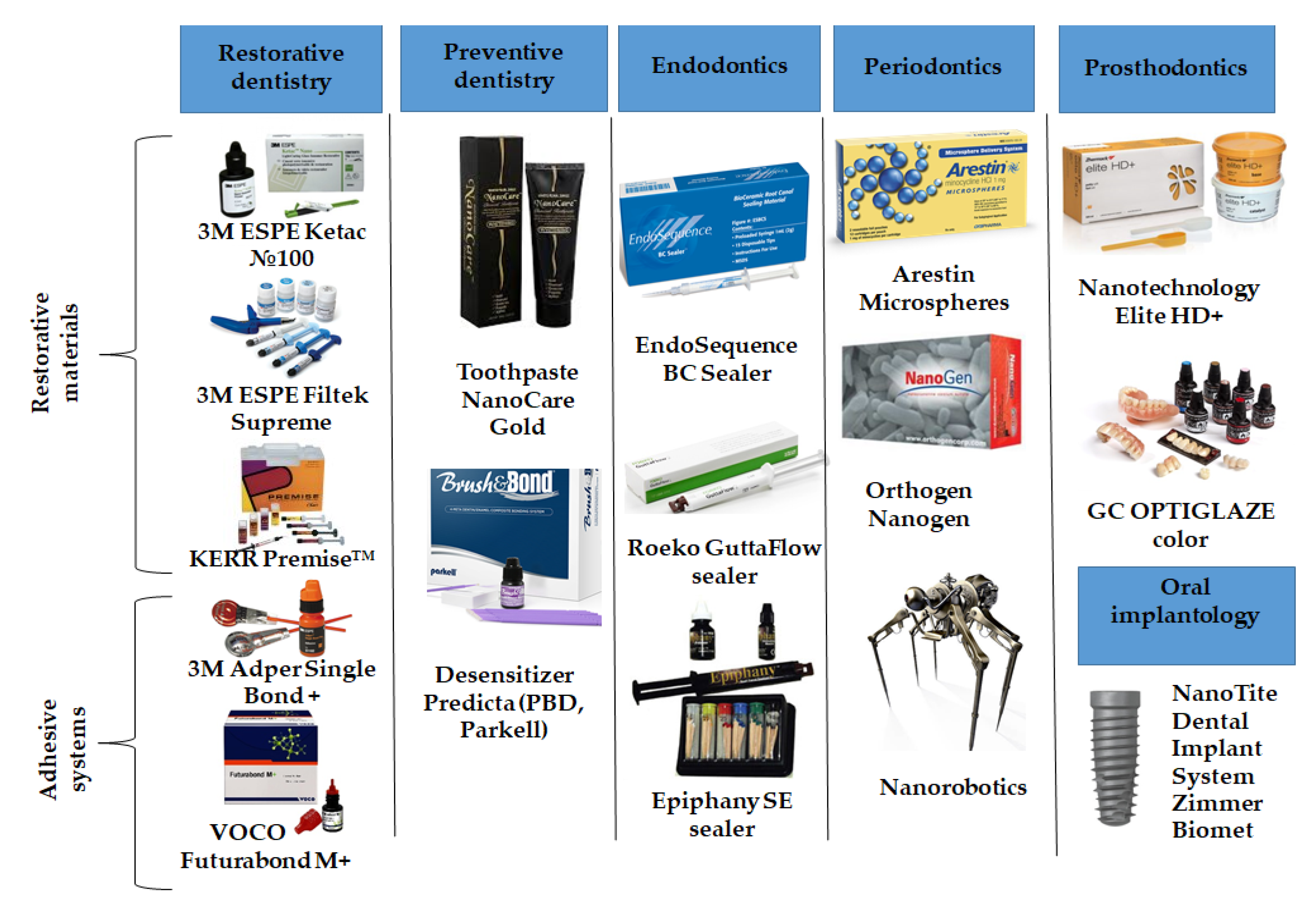
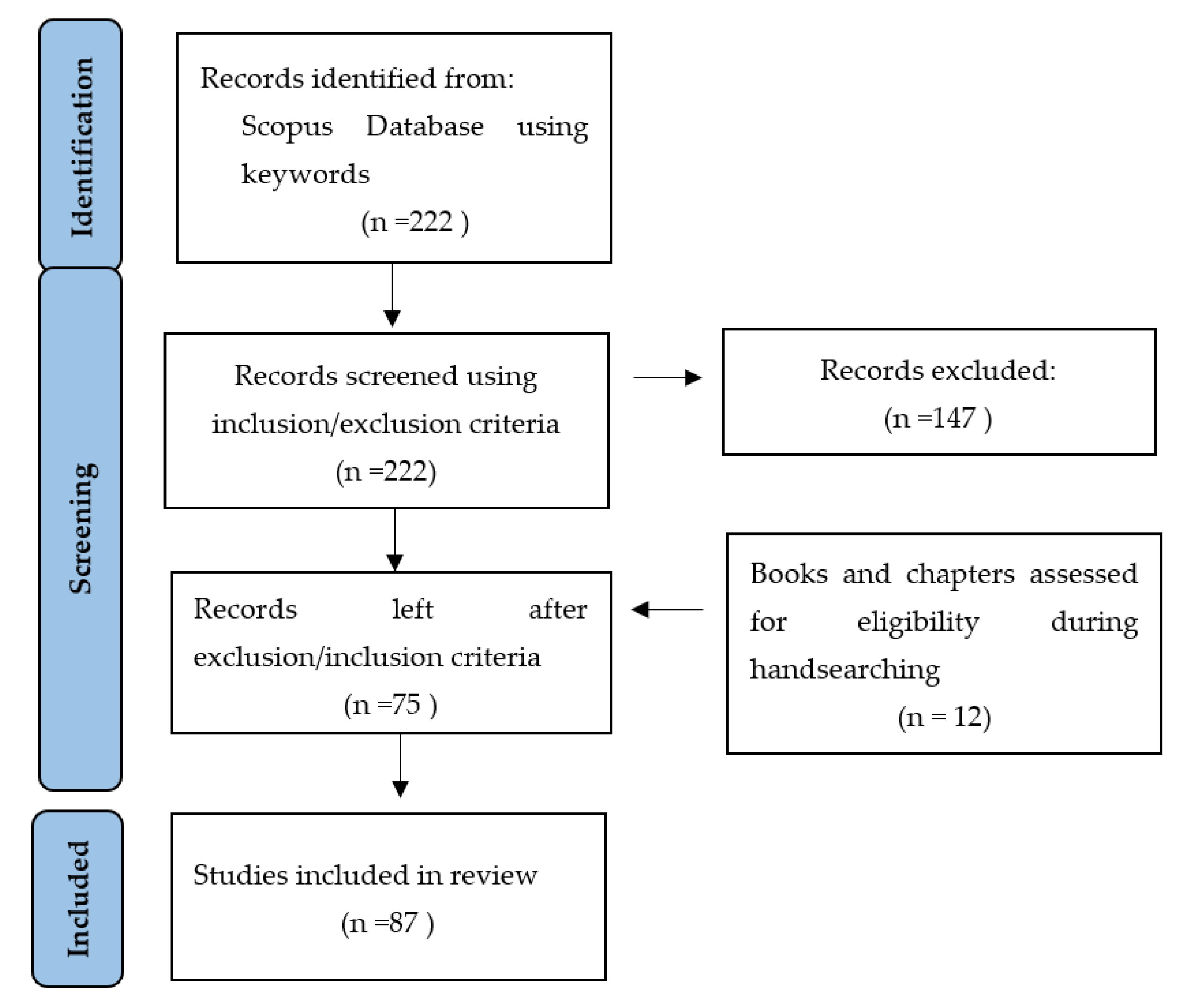
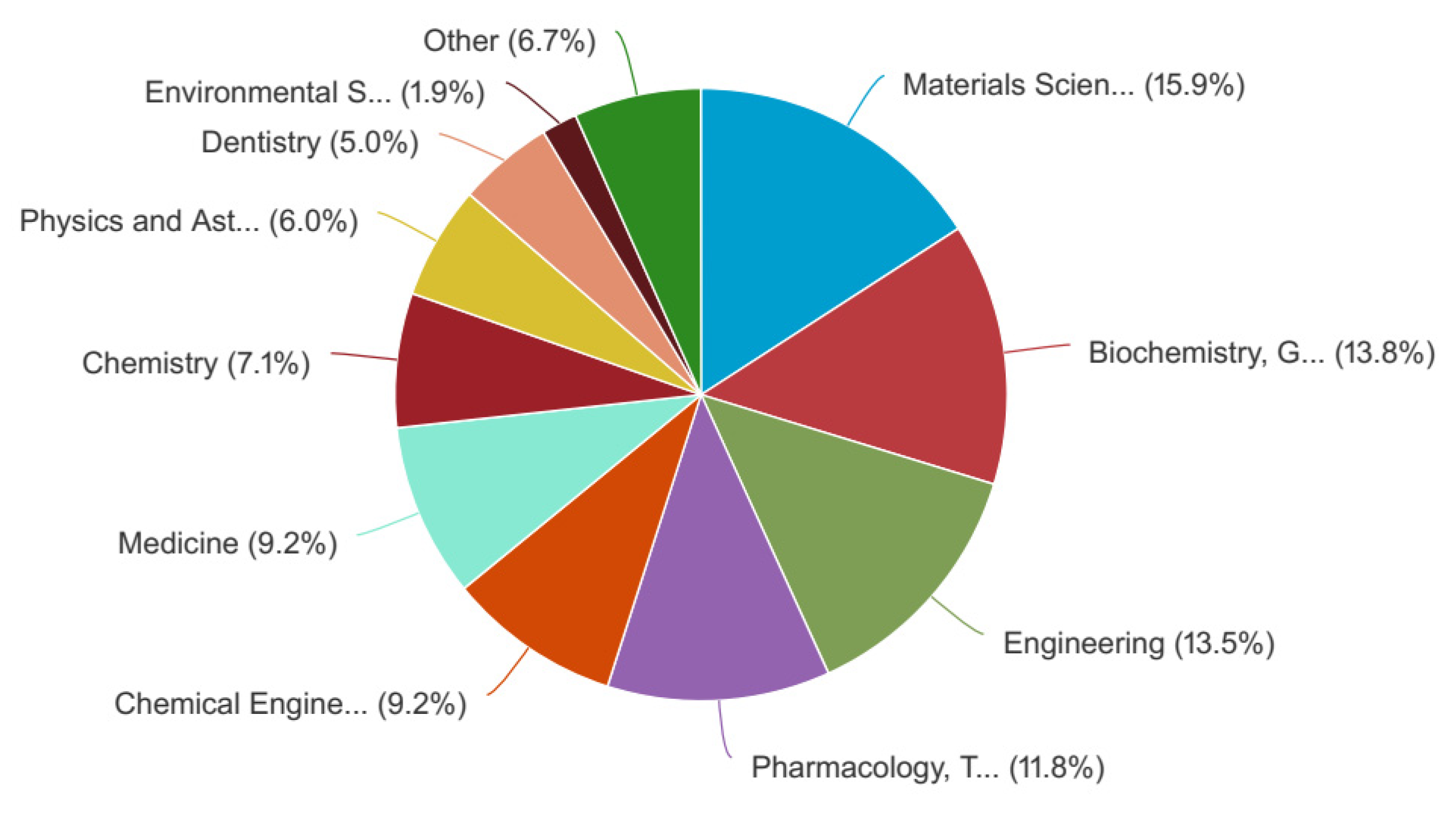


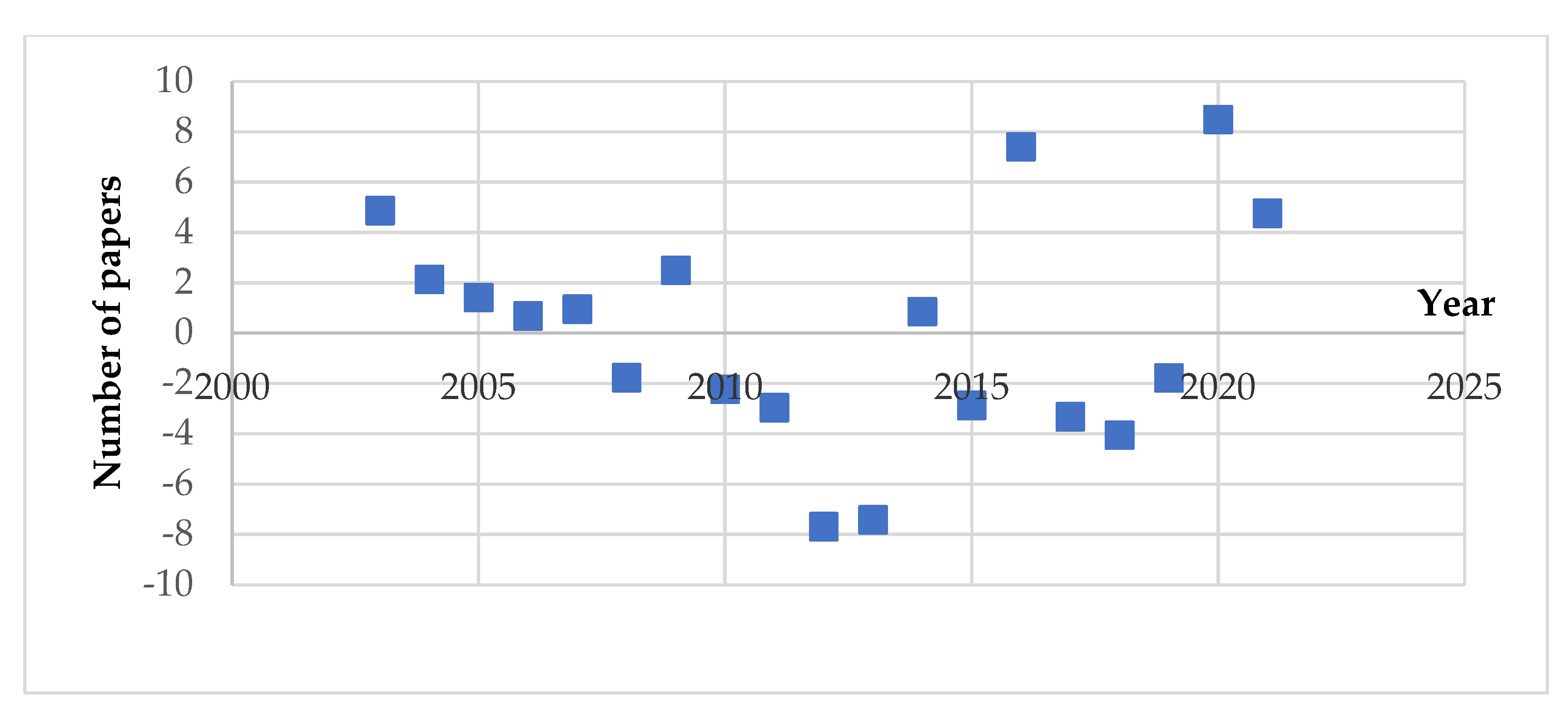

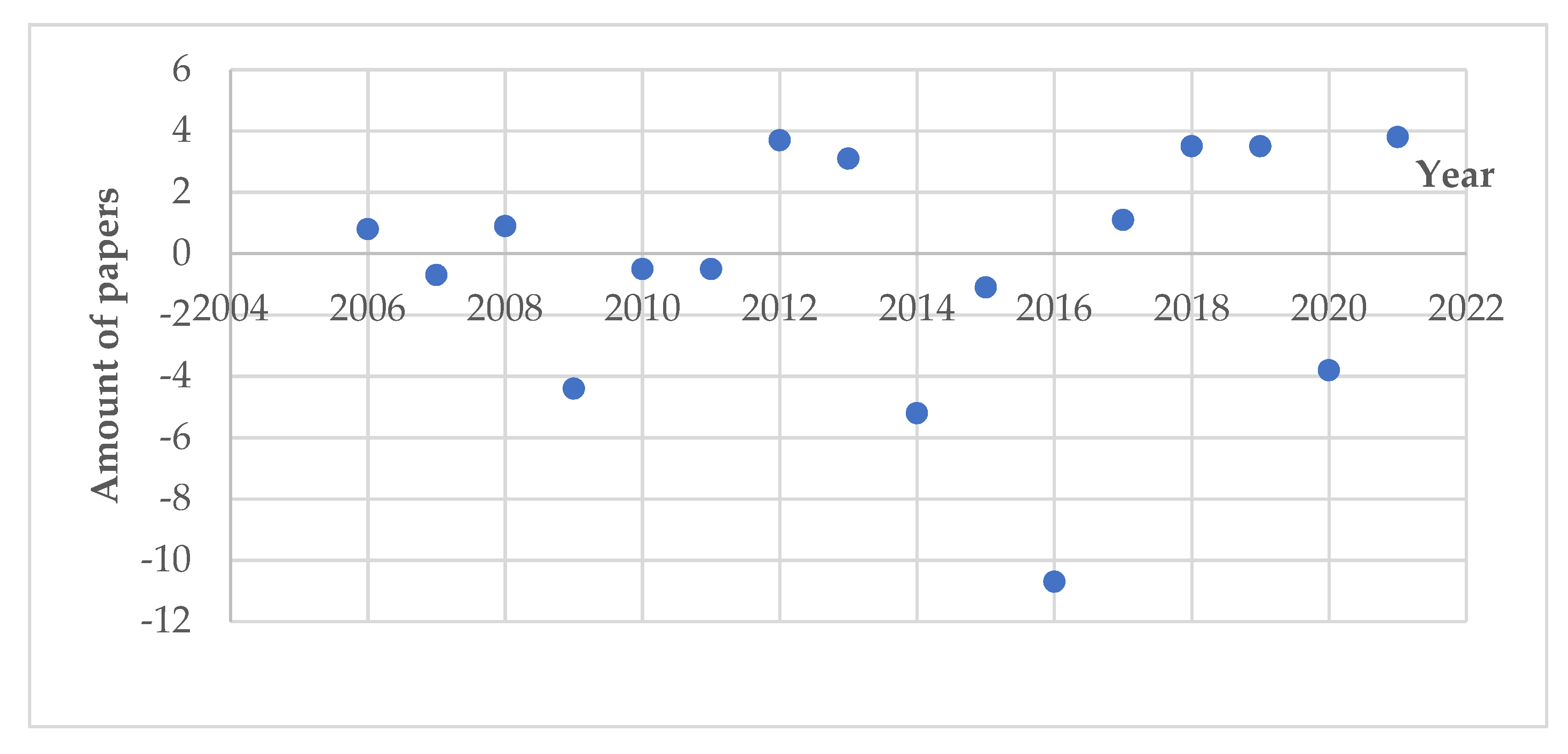

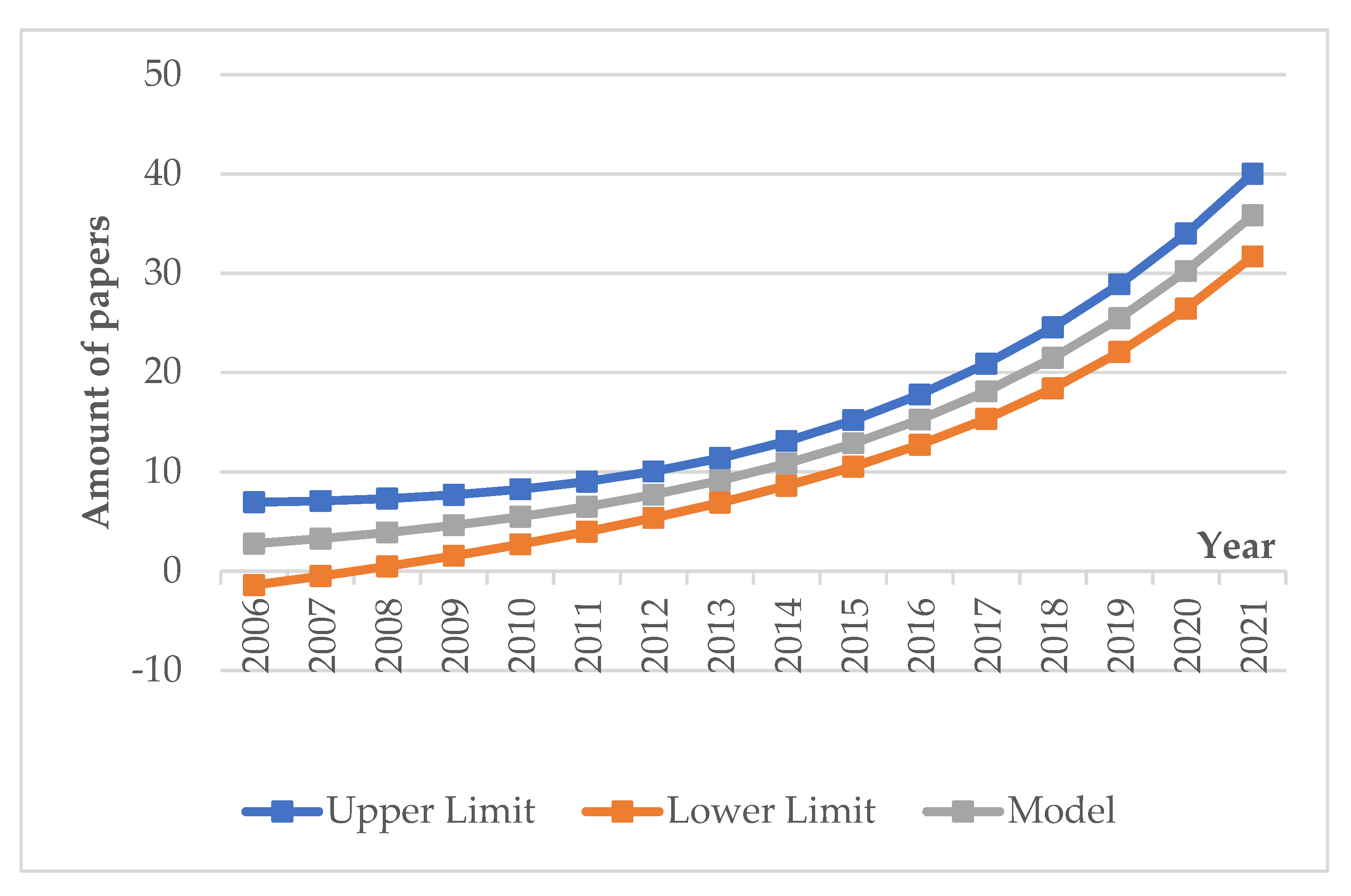
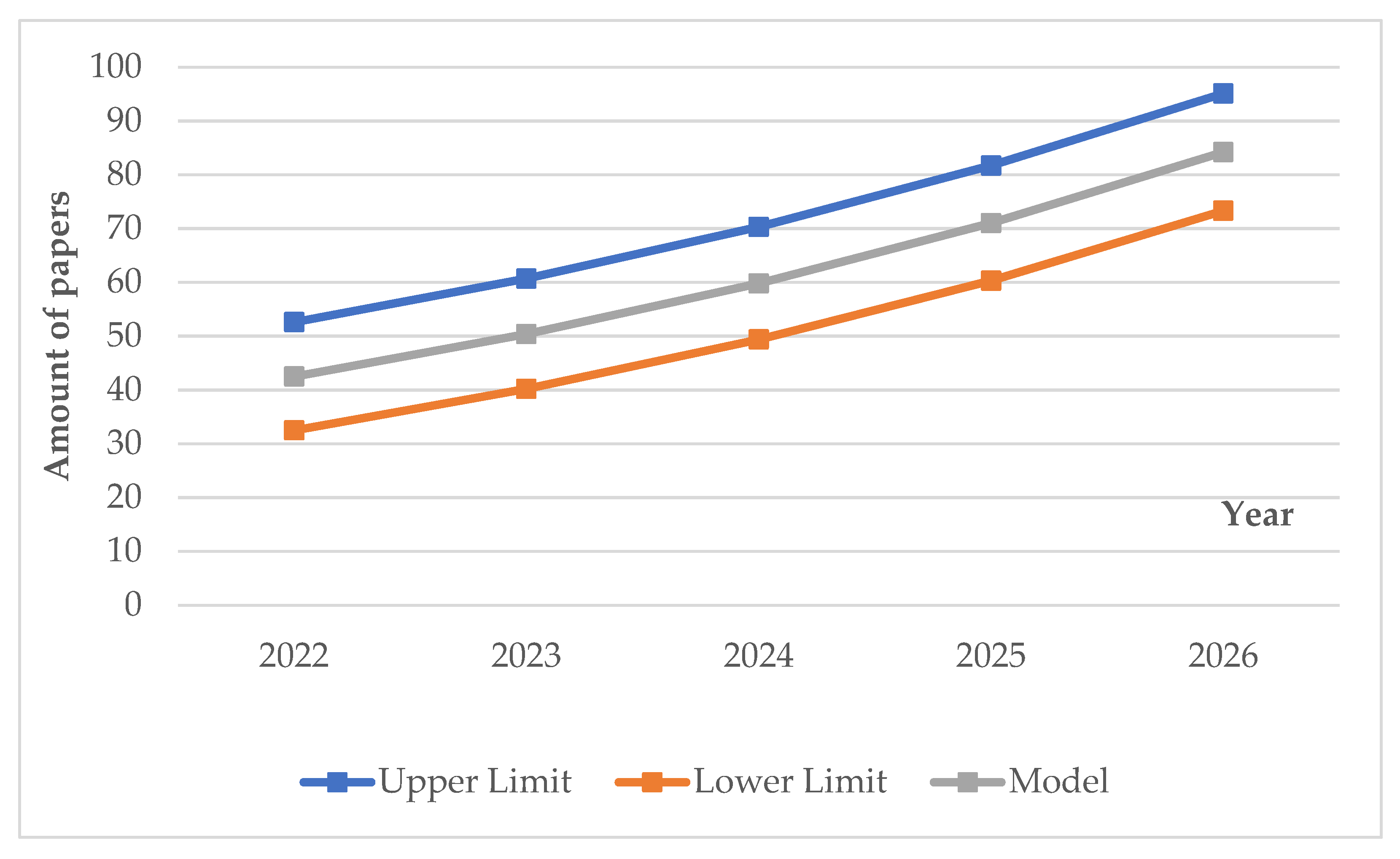

| Year (Independent Variable), x | 6 | 7 | 8 | 9 | 10 | 11 | 12 | 13 | 14 | 15 | 16 | 17 | 18 | 19 | 20 | 21 |
| Number of Papers (Dependent Variable), y | 2 | 4 | 3 | 9 | 6 | 7 | 4 | 6 | 16 | 14 | 26 | 17 | 18 | 22 | 34 | 32 |
| Year | x (Year) | y (Number of Papers) | ŷ (Number of Papers (Model)) | u (Residuals) |
|---|---|---|---|---|
| 2006 | 6 | 2 | 2.1 | 0.1 |
| 2007 | 7 | 4 | 2.9 | −1.1 |
| 2008 | 8 | 3 | 3.8 | 0.8 |
| 2009 | 9 | 9 | 4.9 | −4.1 |
| 2010 | 10 | 6 | 6.1 | 0.1 |
| 2011 | 11 | 7 | 7.4 | 0.4 |
| 2012 | 12 | 4 | 8.9 | 4.9 |
| 2013 | 13 | 6 | 10.6 | 4.6 |
| 2014 | 14 | 16 | 12.3 | −3.7 |
| 2015 | 15 | 14 | 14.2 | 0.2 |
| 2016 | 16 | 26 | 16.3 | −9.7 |
| 2017 | 17 | 17 | 18.5 | 1.5 |
| 2018 | 18 | 18 | 20.8 | 2.8 |
| 2019 | 19 | 22 | 23.3 | 1.3 |
| 2020 | 20 | 34 | 26 | −8 |
| 2021 | 21 | 32 | 28.7 | −3.3 |
| Year | x (Year) | y (Number of Papers) | ŷ (Number of Papers (Model)) | u (Residuals) |
|---|---|---|---|---|
| 2006 | 6 | 2 | 2.8 | 0.8 |
| 2007 | 7 | 4 | 3.3 | −0.7 |
| 2008 | 8 | 3 | 3.9 | 0.9 |
| 2009 | 9 | 9 | 4.6 | −4.4 |
| 2010 | 10 | 6 | 5.5 | −0.5 |
| 2011 | 11 | 7 | 6.5 | −0.5 |
| 2012 | 12 | 4 | 7.7 | 3.7 |
| 2013 | 13 | 6 | 9.1 | 3.1 |
| 2014 | 14 | 16 | 10.8 | −5.2 |
| 2015 | 15 | 14 | 12.9 | −1.1 |
| 2016 | 16 | 26 | 15.3 | −10.7 |
| 2017 | 17 | 17 | 18.1 | 1.1 |
| 2018 | 18 | 18 | 21.5 | 3.5 |
| 2019 | 19 | 22 | 25.5 | 3.5 |
| 2020 | 20 | 34 | 30.2 | −3.8 |
| 2021 | 21 | 32 | 35.8 | 3.8 |
| Year | Upper Limit | Lower Limit | Model |
|---|---|---|---|
| 2006 | 6.9 | −1.4 | 2.8 |
| 2007 | 7.1 | −0.5 | 3.3 |
| 2008 | 7.3 | 0.5 | 3.9 |
| 2009 | 7.7 | 1.5 | 4.6 |
| 2010 | 8.2 | 2.7 | 5.5 |
| 2011 | 9 | 4 | 6.5 |
| 2012 | 10 | 5.4 | 7.7 |
| 2013 | 11.4 | 6.9 | 9.1 |
| 2014 | 13.1 | 8.6 | 10.8 |
| 2015 | 15.2 | 10.5 | 12.9 |
| 2016 | 17.8 | 12.7 | 15.3 |
| 2017 | 20.9 | 15.3 | 18.1 |
| 2018 | 24.5 | 18.4 | 21.5 |
| 2019 | 28.9 | 22.1 | 25.5 |
| 2020 | 34 | 26.4 | 30.2 |
| 2021 | 40 | 31.7 | 35.8 |
| Year | Upper Limit | Lower Limit | Model Forecast |
|---|---|---|---|
| 2022 | 52.6 | 32.5 | 42.5 |
| 2023 | 60.7 | 40.2 | 50.4 |
| 2024 | 70.3 | 49.4 | 59.8 |
| 2025 | 81.7 | 60.3 | 71.0 |
| 2026 | 95.1 | 73.3 | 84.2 |
| Name of Nanoparticle | Advantages/Disadvantages | Mechanism of Co-Interaction | Examples of Materials | Reason for Introduction into Material |
|---|---|---|---|---|
| NAg (nanoparticles of silver) | Antibacterial/can alter color of tooth or restoration | A bactericidal effect is achieved by interactions with the peptidoglycan cell wall and the plasma membrane; silver ions prevent bacterial DNA replication by interacting with the exposed sulfhydryl groups in bacterial proteins | Composite resin; dental adhesives | NAg and NZnO have been incorporated in dental materials to kill cariogenic microorganisms in the marginal gaps and on the material surfaces |
| NZnO (nano zinc oxide particle) | Antibacterial action against several types of microorganisms, including S. Mutans/no evidence about increased mechanical properties | Bactericidal effect is due to modified cell membrane activity and oxidative stress; these generate active oxygen species such as H2O2 that inhibit growth of planktonic microbes | Composite resin | |
| Quaternary ammonium polyethylenimine nanoparticles | An antibacterial agent is copolymerized with the resin by forming a covalent bond with the polymer network, and therefore is immobilized in the composite and not released or lost over time | Cause bacterial lysis by binding to the cell membrane and causing cytoplasmic leakage | Composite resin; glassionomer cement | Provide durable and permanent antibacterial capability to the dental material without significantly affecting the biologic balance in the oral cavity |
| Calcium phosphate nanoparticles | Remineralizing ability: can promote remineralization without loss of the mechanical characteristics of restorative material | Continuous release of calcium (Ca) and phosphate (PO4) ions into oral environment increase the mineral content in the caries lesions | Composite resin; adhesive systems; glassionomer cement | The presence of ACP (amorphous calcium phosphate) nanofillers (NACP) in dental composite resins is an approach to release calcium and phosphate ions continuously into the oral environment |
| Calcium fluoride nanoparticles (CaF2) | High fluoride release: caries-inhibiting effect without compromising on mechanical strength | Cumulative fluoride release increases with nano CaF2 content, and resin composites containing 20–30% of CaF2 nanoparticles have the same fluoride release rates as traditional and resin-modified glass ionomer materials | Composite resin | To inhibit cariogenic bacteria and reduce secondary caries rate |
| Nano hydroxyapatite and nano fluorohydroxyapatite (NHA, NFHA) | An increased resistance to demineralization when incorporated into glassionomer cement (GICs)/exceeded the clinically suitable maximum setting time when added into GICs | Has remineralization effect and biological compatibility of synthesized NHA; is used as substitute for the natural mineral constituent of dentin | Resin modified glassionomer | Remineralization rates with NFHA are higher than with micro bioactive glass particles |
Publisher’s Note: MDPI stays neutral with regard to jurisdictional claims in published maps and institutional affiliations. |
© 2022 by the authors. Licensee MDPI, Basel, Switzerland. This article is an open access article distributed under the terms and conditions of the Creative Commons Attribution (CC BY) license (https://creativecommons.org/licenses/by/4.0/).
Share and Cite
Kochan, O.; Boitsaniuk, S.; Levkiv, M.; Przystupa, K.; Manashchuk, N.; Pohoretska, K.; Chornij, N.; Tsvyntarna, I.; Patskan, L. Emergence of Nano-Dentistry as a Reality of Contemporary Dentistry. Appl. Sci. 2022, 12, 2008. https://doi.org/10.3390/app12042008
Kochan O, Boitsaniuk S, Levkiv M, Przystupa K, Manashchuk N, Pohoretska K, Chornij N, Tsvyntarna I, Patskan L. Emergence of Nano-Dentistry as a Reality of Contemporary Dentistry. Applied Sciences. 2022; 12(4):2008. https://doi.org/10.3390/app12042008
Chicago/Turabian StyleKochan, Orest, Svitlana Boitsaniuk, Mariana Levkiv, Krzysztof Przystupa, Nadiia Manashchuk, Khrystyna Pohoretska, Natalia Chornij, Iryna Tsvyntarna, and Liudmyla Patskan. 2022. "Emergence of Nano-Dentistry as a Reality of Contemporary Dentistry" Applied Sciences 12, no. 4: 2008. https://doi.org/10.3390/app12042008







